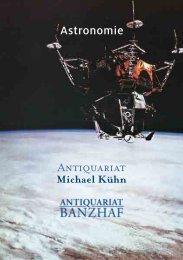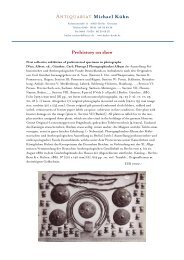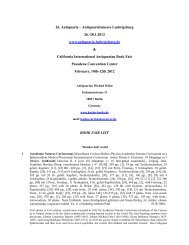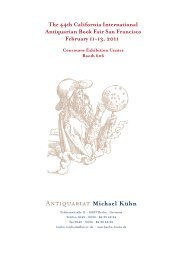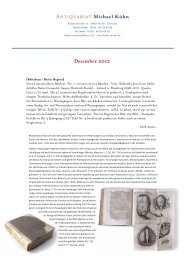List New York Antiquarian Book Fair - Antiquariat - Michael Kühn
List New York Antiquarian Book Fair - Antiquariat - Michael Kühn
List New York Antiquarian Book Fair - Antiquariat - Michael Kühn
Create successful ePaper yourself
Turn your PDF publications into a flip-book with our unique Google optimized e-Paper software.
industrial town more than any other work at that time and contained many of the notions that became widely<br />
accepted with the aesthetic functionalism of the early twentieth century." (Liane Lefaivre, Alexander Tzonis, The<br />
emergence of modern architecture, S. 479). "Seine Vorlesungen erschienen ab 1802 unter dem Titel 'Precis des<br />
lecons d'architecture', die in ihren Nachdrucken und Übersetzungen zum folgen-reichsten Architekturtraktat der<br />
ersten Hälfte des 19. Jahrhunderts wurden." (Kruft, Geschichte der Architek-turtheorie, S. 311). "Durand nimmt<br />
mit seiner Architekturtheorie in vielen Punkten den Funktionaismus der 1920er Jahre vorweg." (a.a.O., S. 312).<br />
Russell, Henry Chamberlaine [ed.] Photographs of the Milky-Way & Nebuculae taken at<br />
Sydney Observatory, 1890. [Sydney], [1891], gr.8°. [6], 16 Original- Photogr. auf<br />
Karton montiert mit begleitendem Text. Original-Umschlag d. Verlags.<br />
$ 9500.-<br />
During his term as Government Astronomer H.C. Russell worked on two internationally significant photographic<br />
projects. The first was the organisation of photography for the <strong>New</strong> South Wales section of the 1874<br />
Transit of Venus. The second was the mapping of the stars in the southern section of the heavens using<br />
photography. Planning for this began in 1887 and started in 1890 after which it continued to play a major<br />
role in the activities at Sydney Observatory up until the 1960s. The success of this project depended upon<br />
a special kind of photographic telescope which was officially known as an 'astrograph' but which Russell<br />
often referred to as the 'Star Camera'. The casing and mounts for the 'Star Camera' were made in <strong>New</strong><br />
South Wales and all the smaller parts and the putting together of the instrument were done by Mr. W. I.<br />
Masters, the instrument maker at The Sydney Observatory. However there were still some aspects of<br />
instrument making which were beyond the skills of Australian manufacturers. One of these was the<br />
making of high quality lenses and in 1887 Russell recommended the purchase of a photographic objective<br />
from the workshops of Sir Howard Grubb in Ireland. The making of a lens was no simple matter and with<br />
other observatory's also requesting lenses Sydney Observatory did not receive theirs until 1890, some<br />
time after the casing and fittings for the 'Star Camera' had been completed. While Russell was waiting on<br />
the arrival of the Grubb lens he placed a six inch portrait lens made by J.H. Dallmeyer on the mounting<br />
for the 'Star Camera". Using Ilford photographic plates he took what were pro-bably the first photographs<br />
of the stars in Australia. Once photographed Russell made copies from the negatives and had them bound<br />
into this book. There is no indication of a printer or publisher inside the book and this suggests it was<br />
probably made in a very limited run by Russell to promote these photographs which Russell, " believed to<br />
be the first of their kind of the Southern Skies." This particular copy of the book was presented to the<br />
<strong>New</strong> South Wales Branch of the British Astronomical Association by H. Wright on 25 September 1923.<br />
These photographic plates are of scientific significance both for their international role in the 'Mapping<br />
the Stars' project and their being one of the earliest scientific photographs of the southern stars. They are<br />
also of immense significance due to their relationship to Australia's early scientific history, its scientists<br />
and the instruments used to create the photographs D.S.B. Supplement pp. 493. nicht Ferguson.<br />
Rydberg Constant<br />
Rydberg, Johannes Robert. Recherches sur la constitution des spectres d'emission des<br />
éléments chimiques par J. R. Rydberg.- Stockholm: Norstedt, 1890 (= Kongl. Svenska Vetenskaps-<br />
Akademiens hand-lingar; N.F., 23, 11) 4°. 155 pp., IV plates. Modern halfleather, fine<br />
condition, but wrappers not bound in. <strong>Book</strong>-Plate: Svante Arrhenius. $ 1800.-<br />
First edition of his famous paper to include the Rydberg formula & constant: a general formula giving the frequency<br />
of the lines in the spectral series as a simple difference between two terms. Spectroscopy had been a<br />
major developed field of physical study for several decades, but its most pressing need near the end of the<br />
nineteenth century was for the organization of its vast amount of data into some mathematically ordered form<br />
that theo-reticians might find useful in their attempts to understand the underlying significance of spectra.<br />
Rydberg’s gene-ral formula was the most important presentation of this type. Many others groped in the same<br />
general direction, mostly with ephemeral results.<br />
Scarce. First edition, Off-Print issue. Rydberg developed a general mathematical formula for expressing all series<br />
in all elementary line spectra, which allowed him to discover some important relationships between types of<br />
series. Rydberg formula was of fundamental importance to Niels Bohr’s quantum theory of the atom (1913),<br />
providing Bohr the means of incorporating the quantum of action into the theory of atomic construction.<br />
[Norman] “His major spectral work, “Recherches sur la constitution des spectres d’émission des éléments<br />
chimiques’, published in 1890, mapped out Rydberg’s total approach with remarkable clarity. He conceived of<br />
the spectrum of an element as composed of the superposition of three different types of series—one in which the



